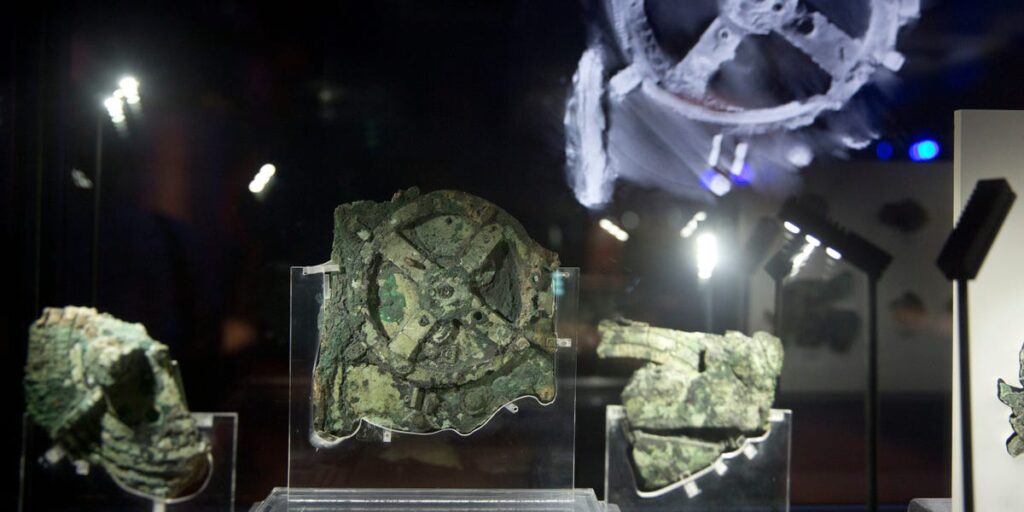Ozan Kose/Getty Images
- Archaeologists use a variety of techniques to learn more about ancient objects.
- But some results remain open to interpretation, leaving mysteries behind.
- This list includes objects with unknown functions, undeciphered scripts, and impressive monuments.
Archeologists use all sorts of objects to learn about humans of the past. Methods like blood residue analysis and radiocarbon dating can help determine what animals people butchered or when a piece of linen textile was woven.
But these techniques can’t solve all mysteries. Sometimes, the data leaves the results open to interpretation.
From objects with unknown functions to undeciphered scripts, here are 11 archaeological finds that still have some unanswered questions.
Sharma Centre for Heritage Education
Hundreds of thousands of years ago, human species exchanged unwieldy hand axes for smaller, easier-to-use stone flakes.
In 2018, researchers announced that they had found evidence of this transition at an archaeological site in southern India called Attirampakkam. The area contained million-year-old hand axes and smaller, more sophisticated tools from between 385,000 and 172,000 years ago. At other sites in India, these smaller tools date to around 100,000 years ago.
There are a couple of possible explanations for the Attirampakkam tools. Either humans brought the technology much earlier than originally thought or another hominin species independently developed similar tools around that time.
“Rather than equating technologies from Europe to Africa to South Asia, you can also recast it as independent invention by large-brained early humans,” paleoanthropologist Michael Petraglia told National Geographic in 2018.
University of Tübingen
Excavating the Hohle Fels cave in Germany has led to some incredible discoveries, from a 35,000-year-old flute to artistic figurines that are even older. One artifact, an eight-inch piece of ivory with grooved holes, wasn’t easy to identify.
Archaeologists have found similar items, known as batons, in the UK and France. Made of ivory or antler, they have holes with grooves on the inside, and some have notches. Researchers thought they could have been musical instruments.
Recently, though, archaeologist Nicholas Conard and his colleagues have found microscopic bits of plant fiber in the holes, leading them to conclude that the ivory baton is actually a tool for making rope from flax, reed, or other material.
Based on descriptions of rope-making with similar tools from the Middle Ages, the researchers recreated the process with a replica of the piece of ivory. This resulted in a sturdy 16 feet of rope.
While that may solve the mystery of some of these batons, there are others with only a single hole that likely weren’t used for this purpose.
iStock via Getty Images
Not long after the end of the last Ice Age, people started constructing t-shaped limestone pillars at Göbekli Tepe in present-day Turkey. There are over 20 enclosures at the site, some over 11,000 years old.
Some of the pillars are 18 feet tall and covered in carvings of animals. Klaus Schmidt, who excavated the site for over 20 years, thought humans would gather, work on the pillars, and hold feasts. Then they would bury their work with rocks and move on from the temple until the next gathering.
However, newer research suggests that Göbekli Tepe was also a domestic settlement where people lived for hundreds of years.
Who lived there, though — hunter-gatherer societies or Neolithic farmers — is an open question. Archaeologist Laura Dietrich thinks the residents were probably a combination of both. “Hunter-gatherer life doesn’t stop immediately because people start cultivating grain,” she told Archaeology Magazine in 2021.
Andrew Aitchison/Getty Images
A calendar? A poem? A hoax? People have suggested all these explanations for the mysterious Phaistos Disc. Archaeologist Luigi Pernier discovered the six-inch clay disc in 1908 in a Minoan palace on the island of Crete. Both sides of the disc were stamped with undeciphered characters arranged in spirals.
Some estimates put the disc’s creation at between 1,850 to 1,600 BC. Experts have called for the disc to be tested via thermoluminescence, a dating technique that would determine whether the disc is a forgery. But the Heraklion Archaeological Museum in Crete, which houses the disc, has declined.
Still, linguists are attempting to unravel the disc’s mysteries. In 2018, University of Melbourne professor Brent Davis published a paper on some commonalities between the disc’s characters and Linear A, another undeciphered script that people have been trying to decrypt for over a century.
Daniel Leal/Getty Images
Roughly 5,000 years ago, around the time Stonehenge was built, someone buried three children in what’s now East Yorkshire, England. They included a chalk ball and polished bone pin in the grave, as well as a sculpture known as the Burton Agnes drum.
The elaborately carved chalk sculpture wasn’t a musical instrument, according to archaeologists. Instead, it may have served as a protective talisman. It’s similar to the Folkton drums, three other decorated sculptures found in an ancient child’s grave in 1889.
The drums may help archaeologists understand more about the area’s Stonehenge-era culture.
“This is a truly remarkable discovery and is the most important piece of prehistoric art to be found in Britain in the last 100 years,” British Museum curator Neil Wilkin said in a statement in 2022.
Associated Press/Petros Giannakouris
The Antikythera device is so sophisticated that some have doubted it could really be 2,200 years old. The shoebox-sized mechanism is made of bronze and has interlocking gears that work like a mechanical computer.
Divers found the device in 1900, along with a host of other treasures, in a 2,000-year-old shipwreck near the Greek island of Antikythera. Seawater has eroded parts of the object, which is broken into pieces.
Recently, researchers determined that because of the number of holes the device has, its owners probably used it to track the Greek lunar year rather than an Egyptian solar calendar, as earlier research suggested.
The mechanism is unique. It would have required extremely accurate measurements to position the 300-plus holes just right to help chart future events like eclipses. It’s so precise that it “single-handedly rewrites our knowledge of the technology of the ancient Greeks,” researcher Tony Freeth wrote in Scientific American in 2022.
Charle He/Getty Images
For over 2,000 years, thousands of life-size terracotta soldiers and horses guarded the tomb of Qin Shi Huang near Xi’an in north-central China. Shortly after the first emperor’s death, a rebel army damaged some of the 8,000 soldiers, but then the figures remained untouched for millennia.
A farmer dug up the first in 1974, and its existence was a complete surprise.
The burial chamber remains untouched. Archaeologists are worried about damaging any treasurers inside, and the soil contains high levels of mercury. Qian said workers forged artificial rivers underground using mercury, but whether that’s true is just one of the many mysteries of the emperor’s tomb. Some experts hope robotic devices can one day enter without causing too much disruption.
Heritage Images/Getty Images
Tourists flock to the Peruvian desert to see a spiral-tailed monkey, gaping whale, and cuddly-looking cat. These geoglyphs depict humans and animals dug into the ground. They’re also accompanied by lines that can span 30 miles, according to National Geographic.
It wasn’t until planes started flying over the desert outside of Lima in the 1920s and ’30s that the Nazca images were rediscovered. Despite their size — some are as large as a cruise ship — they’re difficult to spot from the ground. Between 2,000 and 500 years ago, people removed the top layer of soil to reveal the lighter sand beneath, creating hundreds of pictures.
Experts think the lines and geoglyphs may be connected with rituals related to concerns like rain and fertility.
New technology is helping scientists spot more geoglyphs. In 2019, researchers used aerial photos and drones to find 168 new images, including snakes and camelids.
JEAN-CHRISTOPHE VERHAEGEN/Getty Images
In 2023, a group of amateur archaeologists were thrilled to find a dodecahedron in the remains of an ancient Roman villa 100 miles outside London.
Roughly the size of a softball and made of copper alloy, the 12-sided device has holes and knobs all over. It’s one of many that people have discovered across what was once the Roman Empire, from present-day France to Croatia to Great Britain.
Because they vary in size and location, including public baths and tombs, no one is quite sure what they were made for. People have suggested they might have been instruments for knitting, religious objects, or candle holders.
Whatever their purpose, the dodecahedrons would have been difficult to make. “They would have been expensive items,” Frances McIntosh, an archaeologist with English Heritage, previously told Business Insider, “likely bespoke commissions.”
Buddy Mays/Getty Images
In the 1930s, the United Fruit Company cleared forests to make way for banana plantations in the Diquís Delta in Costa Rica. That’s when scientists started writing about the hundreds of stone balls found in the area.
The spheres, carved from a basalt-like rock called gabbro, come in a variety of sizes. Some are as large as eight feet in diameter and weigh as much as three elephants. Exactly when the local population made the spheres is unclear due to difficulties with dating techniques, but researcher John Hoopes puts their age at around 600 to 1,000 AD.
“We really don’t know why they were made,” Hoopes said in a 2010 statement about his research.
DeAgostini/Getty Images
Wooden tablets that no living person knows how to read have been found in Rapa Nui, also known as Easter Island. There are a couple dozen examples of rongorongo script, which is made up of glyphs or pictorial images.
The script doesn’t seem to resemble European writing, so it’s possible locals developed it before Dutch explorers arrived in 1722. Researchers dated one of the pieces of wood to between 1493 and 1509. The three other tablets come from the 18th and 19th centuries.
It’s possible someone carved glyphs into an older piece of wood around the same time. The 500-year-old wood adds to the writing’s mystery.
Testing the rest of the tablets could help determine the script’s age. “I actually believe that rongorongo is one of the very few independent inventions of writing in human history, like the writing of the Sumerians, the Egyptians, and the Chinese,” Rafal Wieczorek, a chemist at the University of Warsaw, told Live Science. “But belief is a different thing than hard data.”
Read the full article here
















